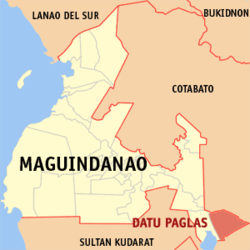Datu Paglas, Maguindanao
Datu Paglas, officially the Municipality of Datu Paglas (Maguindanaon: Ingud nu Datu Paglas; Iranun: Inged a Datu Paglas; Tagalog: Bayan ng Datu Paglas), is a 4th class municipality in the province of Maguindanao, Philippines. According to the 2015 census, it has a population of 28,387 people.[3]
Datu Paglas | |
|---|---|
| Municipality of Datu Paglas | |
 Map of Maguindanao with Datu Paglas highlighted | |
OpenStreetMap 
| |
.svg.png) Datu Paglas Location within the Philippines | |
| Coordinates: 6°46′01″N 124°51′00″E | |
| Country | |
| Region | Bangsamoro Autonomous Region in Muslim Mindanao (BARMM) |
| Province | Maguindanao |
| District | 2nd District |
| Founded | November 22, 1973 |
| Barangays | 23 (see Barangays) |
| Government | |
| • Type | Sangguniang Bayan |
| • Mayor | Abubakar P. Paglas |
| • Vice Mayor | Mohamad P. Paglas Sr. |
| • Congressman | Esmael G. Mangudadatu |
| • Electorate | 19,604 voters (2019) |
| Area | |
| • Total | 132.10 km2 (51.00 sq mi) |
| Population (2015 census)[3] | |
| • Total | 28,387 |
| • Density | 210/km2 (560/sq mi) |
| • Households | 4,642 |
| Economy | |
| • Income class | 4th municipal income class |
| • Poverty incidence | 52.71% (2015)[4] |
| • Revenue (₱) | 71,300,123.13 (2016) |
| Time zone | UTC+8 (PST) |
| ZIP code | 9617 |
| PSGC | |
| IDD : area code | +63 (0)64 |
| Climate type | tropical climate |
| Native languages | Maguindanao Tagalog |
Barangays
Datu Paglas is politically subdivided into 23 barangays.[5]
- Alip (Poblacion)
- Bonawan
- Bulod
- Damalusay
- Damawato
- Datang
- Elbebe
- Kalumenga (Kalumanga)
- Katil
- Lipao
- Lomoyon
- Madidis
- Makat
- Malala
- Mangadeg
- Manindolo
- Mao
- Napok
- Palao sa Buto
- Poblacion
- Puya
- Salendab
- Sepaka
History
Datu Paglas was created out of 7 northern barangays of the municipality of Columbio on November 22, 1973, by Presidential Decree No. 340.[6] While Columbio was made part of the province of Sultan Kudarat, Datu Paglas was made part of the province of Maguindanao.[7]
Climate
| Climate data for Datu Paglas, Maguindanao | |||||||||||||
|---|---|---|---|---|---|---|---|---|---|---|---|---|---|
| Month | Jan | Feb | Mar | Apr | May | Jun | Jul | Aug | Sep | Oct | Nov | Dec | Year |
| Average high °C (°F) | 31 (88) |
31 (88) |
32 (90) |
32 (90) |
31 (88) |
30 (86) |
30 (86) |
30 (86) |
30 (86) |
30 (86) |
30 (86) |
31 (88) |
31 (87) |
| Average low °C (°F) | 23 (73) |
23 (73) |
23 (73) |
24 (75) |
24 (75) |
24 (75) |
24 (75) |
24 (75) |
24 (75) |
24 (75) |
24 (75) |
24 (75) |
24 (75) |
| Average precipitation mm (inches) | 64 (2.5) |
45 (1.8) |
59 (2.3) |
71 (2.8) |
140 (5.5) |
179 (7.0) |
192 (7.6) |
198 (7.8) |
163 (6.4) |
147 (5.8) |
113 (4.4) |
66 (2.6) |
1,437 (56.5) |
| Average rainy days | 12.2 | 10.3 | 12.7 | 15.7 | 26.0 | 27.4 | 28.1 | 28.2 | 26.0 | 26.7 | 22.9 | 16.6 | 252.8 |
| Source: Meteoblue (modeled/calculated data, not measured locally) [8] | |||||||||||||
Demographics
| Year | Pop. | ±% p.a. |
|---|---|---|
| 1975 | 6,816 | — |
| 1980 | 8,262 | +3.92% |
| 1990 | 13,970 | +5.39% |
| 1995 | 15,522 | +1.99% |
| 2000 | 20,014 | +5.60% |
| 2010 | 20,290 | +0.14% |
| 2015 | 28,387 | +6.60% |
| Source: Philippine Statistics Authority[3][9][10][11] | ||
References
- "Municipality". Quezon City, Philippines: Department of the Interior and Local Government. Retrieved 31 May 2013.
- "Province: Maguindanao". PSGC Interactive. Quezon City, Philippines: Philippine Statistics Authority. Retrieved 12 November 2016.
- Census of Population (2015). "ARMM – Autonomous Region in Muslim Mindanao". Total Population by Province, City, Municipality and Barangay. PSA. Retrieved 20 June 2016.
- "PSA releases the 2015 Municipal and City Level Poverty Estimates". Quezon City, Philippines. Retrieved 12 October 2019.
- National Statistical Coordination Board. "PSGC Interactive: Municipality/City: DATU PAGLAS". Archived from the original on 2007-11-24. Retrieved 2008-05-19.
- Chan Robles Virtual Law Library (1998-07-19). "Presidential Decree No. 340". Retrieved 2008-05-19.
- Chan Robles Virtual Law Library (1998-07-19). "Presidential Decree No. 341". Retrieved 2008-05-18.
- "Datu Paglas, Maguindanao : Average Temperatures and Rainfall". Meteoblue. Retrieved 19 January 2019.
- Census of Population and Housing (2010). "ARMM – Autonomous Region in Muslim Mindanao". Total Population by Province, City, Municipality and Barangay. NSO. Retrieved 29 June 2016.
- Censuses of Population (1903–2007). "ARMM – Autonomous Region in Muslim Mindanao". Table 1. Population Enumerated in Various Censuses by Province/Highly Urbanized City: 1903 to 2007. NSO.
- "Province of Maguindanao". Municipality Population Data. Local Water Utilities Administration Research Division. Retrieved 17 December 2016.
External links
This article is issued from Wikipedia. The text is licensed under Creative Commons - Attribution - Sharealike. Additional terms may apply for the media files.